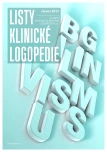A nonword repetition ability as a complement to a family history of a child
Authors:
Mgr. Kapalková Svetlana, PhD. 1; Mgr. Tokárová Oľga, PhD. 2
Authors‘ workplace:
Katedra logopédie, Ústav psychologických a logopedických štúdií PdF Univerzity Komenského, Račianska 59, 813 34 Bratislava, kapalkova@fedu. uniba. sk
1; Súkromné centrum špeciálno-pedagogického poradenstva – Inštitút detskej reči
2
Published in:
Listy klinické logopedie 2017; 1(1): 56-60
Category:
Miscellaneous
Overview
The pathomechanism of Specific Language Impairment (SLI) is generally viewed as the disruption of the processing of the acoustic signal and the short term phonological memmory weakening (Smolík, 2009). At the time it’s shown, that in some families, the occurrence of Language Impairment is visibly higher (Leonard, 2000) than in other families. The Non-Word repeatition task is a sensitive and fast instrument for the children identifided at risk for LI, precisely due to the fact that it’s based on the analysis and processing of quickly changing, and shortly lasting sound signals without any support of the word meaning (Kapalková, Polišenská, Vicenová, 2013). We asked ourselves, if the parents of the children with language difficulties also show a deficit in the area of short term phonological memory. We decided to confirm this hypothesis by a generally accepted diagnostic marker - the Non-Word repetition task, which both parents of the children with LI were tested with. Their scores were then compared with the ones of the parents of typically developing children The results show, that the parents of children with LI statistically have a much lower score in Non-word repetition task than the parents of the children from the control group. The gained data confirms the existence of a genetical predisposition for language difficulties in watched slovak speaking families.
Key words
Nonword, children at risk, specific language impairmant, language impairment, family history, parents, genetical predisposition
Sources
-
ARMON - LOTEM, Sharon a Natalia MEIR. Diagnostic accuracy of repetition tasks for the identification of specific language impairment (SLI) in bilingual children: Evidence from Russian and Hebrew. International Journal of Language and Communication Disorders. 2016, 51(6), 715 - 731.
-
BISHOP, Dorothy V. Ten questions abuot terminology fo children with unexplained language problems. International Journal of Language & Communication Disorders. 2014, 49(4), 381 - 415.
-
DALE, Philip a Melissa PENFOLD. Adaptations of the MacArthur-Bates CDI Into Non‐U.S. English Languages [online]. 2011 [cit. 2017-04-05]. Dostupné z: https://mb-cdi.stanford.edu/adaptations.html
-
HODGES, Rosemary, Natalie MUNRO, Elise BAKER, Karla MCGREGOR a Rob HEARD. The Monosyllable Imitation Test for Toddlers: influence of stimulus characteristics on imitation, compliance and diagnostic accuracy. International Journal of Language & Communication Disorders. 2017, 52(1), 30 - 45.
-
CHIAT, Shula. Non-Word Repetition. In: Assessing Multilingual Children: Disentangling Bilingualism from Language Impairment. Toronto: Multilingual Matters, 2015, 125 - 150. ISBN 978-1-78309-311-3.
-
CHIAT, Shula a Penny ROY. The preschool repetition test: An evaluation of performance in typically developing and clinically referred children. Journal of Speech, Language, and Hearing Research. 2007, 50(2), 429 - 443.
-
KAPALKOVÁ, Svetlana, Kamila POLIŠENSKÁ a Zuzana VICENOVÁ. Non-word repetition performance in Slovak-speaking children with and without SLI: novel scoring methods. International Jouranl of Language & Communication Disorders. 2013, 48(1), 78 - 89.
-
KAPALKOVÁ, Svetlana, Daniela SLANČOVÁ, Iveta BÓNOVÁ, Jana KESSELOVÁ a Marína MIKULAJOVÁ. Hodnotenie komunikačných schopností detí v ranom veku. Bratislava: MABAG spol. s r.o., 2010. ISBN 978-80-89113-83-5.
-
LEONARD, Laurence B. Children with Specific Language Impairment. Massachusetts: The MIT Press, 1998. ISBN 0-262-12206-5.
-
MARKOVÁ, Jana a Marína MIKULAJOVÁ. Oral Sentence Comprehension in Slovak-Speaking, Typically Developing Children, in Children with a Specific Language Impairment, and in Children with Dyslexia. Journal of Speech and Language Pathology. 2011, 1(1), 27 -47.
-
MIKULAJOVÁ, Marína. Vývin reči. In: Logopédia. Bratislava: Univerzita Komenského, 13 - 35. ISBN 978-80-223-4165-3.
-
MIKULAJOVÁ, Marína a Iris RAFAJDUSOVÁ. Vývinová dysfázia: Špecificky narušený vývin reči. Bratislava: Dialóg spol. s r.o., 1993. ISBN 80-900445-0-6.
-
POLIŠENSKÁ, Kamila a Svetlana KAPALKOVÁ. Improving Child Compliance on a Computer-Administered Nonword Repetition Task. Journal of Speech, Language, and Hearing Research. 2014, 57(June), 1060 - 1068.
-
SHAHMAHMOOD, Toktam Maleki, Shohre, JALAI, Zahra SOLEYMANI, Haresabadi FATEMEH a Nemati PARVIN. A systematic review on diagnostic procedures for specific language impairment. The sensitivity and specificity issues. Journal of Research in Medical Sciences. 2016, 21(5), 16.
-
SMOLÍK, Filip. Vývojová dysfázie a struktura raných jazykových schopností. Československá Psychologie. 2009, 53(1), 40 - 54.
Labels
Clinical speech therapy General practitioner for children and adolescentsArticle was published in
Clinical speech therapy (Listy klinické logopedie)

2017 Issue 1
Most read in this issue
- Bilingualism and education of children in a bilingual family
- Selected myths in relation to bilingualism
- The impact of changes in multilingual environment on child‘s speech development
- A nonword repetition ability as a complement to a family history of a child
